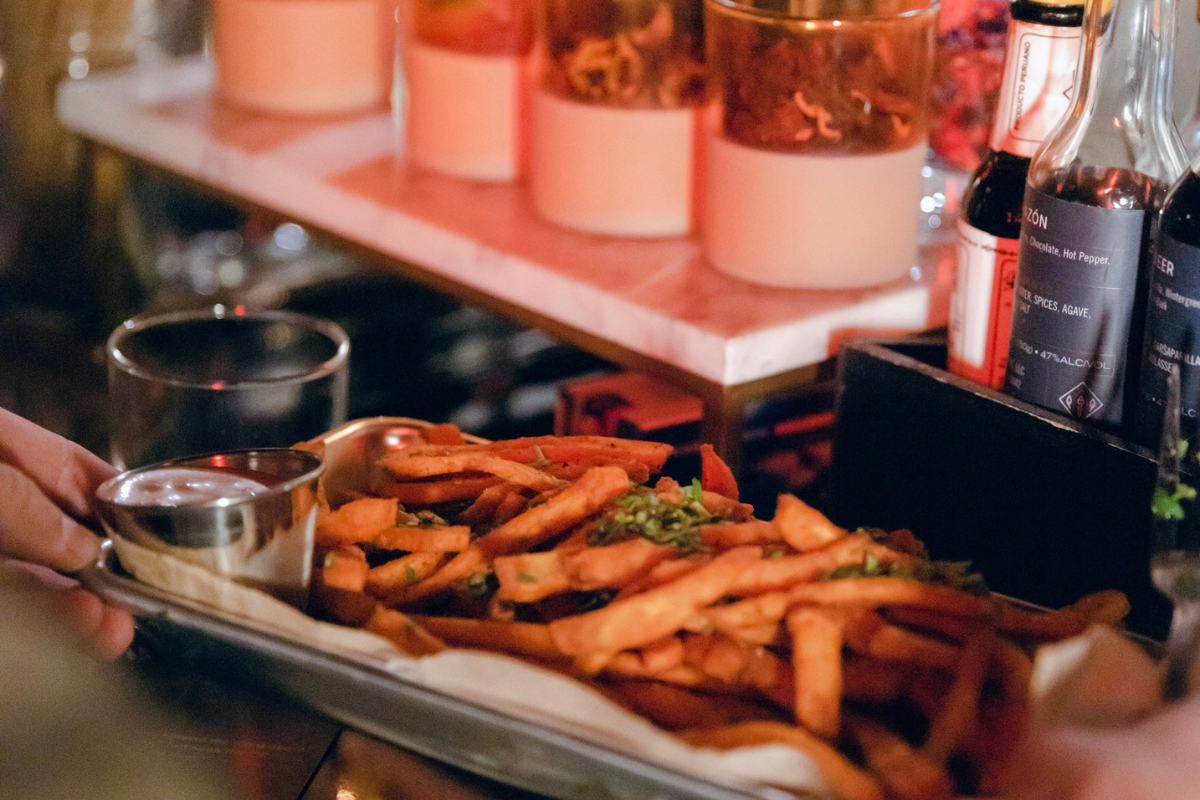Home
Restaurants
Hand-Pulled Noodles at Oishi Ramen: Where Ancient Chinese Noodle Art Meets South Salt Lake's Chinatown
Hand-Pulled Noodles at Oishi Ramen: Where Ancient Chinese Noodle Art Meets South Salt Lake's Chinatown
You can hear the rhythmic slap of dough against the counter before you even sit down. From your table at Oishi Ramen, just off State Street near Salt Lake's Chinatown Supermarket, you watch as the chef's hands transform a simple ball of wheat dough into impossibly long, uniform strands. It's the ancient art of Lanzhou lamian—hand-pulled noodles—and one of the few places in Utah where you can witness this 4,000-year-old technique happening right in front of you. "While the food took a bit to get to the table it was most definitely worth the wait, plus being able to watch the chef cook and hand pull noodles with nothing more than his hands makes the time pass by quickly," one customer notes, capturing that mesmerizing pull between hunger and fascination.
This isn't just dinner theater for tourists. At Oishi Ramen, located at 3424 S State Street in South Salt Lake, those hand-pulled noodles represent something deeper—a commitment to preserving traditional Chinese noodle-making methods while serving both authentic Chinese and Japanese ramen styles under one roof. It's a rare duality in Utah's ramen scene, and it's exactly what makes this unassuming spot near the edge of Salt Lake's multicultural corridor worth your attention.

The Ancient Craft Behind Your Bowl: Hand-Pulled Noodle Tradition
The hand-pulled noodles at Oishi Ramen aren't just fresh—they're made using the Lanzhou lamian technique, a method that dates back centuries in China's Gansu province. According to the restaurant's philosophy, "A bowl of noodle soup might seem plain, like nothing special, but once you try it, you'll be amazed at how such a simple food tastes so good and is so addictive. Isn't it a bit obsessive, you ask? Yes it is. Because it's not just a bowl of noodle soup. It's an art."
That art requires serious skill. Traditional Lanzhou lamian involves repeatedly folding and pulling a single piece of dough—each pull doubling the number of strands—until you achieve the desired thickness. Some masters can create noodles thin enough to thread through a needle after seven pulls, though most restaurants serve noodles made with five to six pulls, resulting in strands similar to spaghetti in thickness. The secret to this elasticity? A combination of technique, timing, and sometimes an alkaline agent that makes the wheat dough extraordinarily stretchy.
One visitor from out of town was pleasantly surprised: "Was in SLC for ski vacation. Accidentally found this place as I was entering the Chinatown Supermarket parking lot. Saw the sign written in Mandarin: 'Authentic Lanzhou Noodles'. Haven't had Lanzhou noodles for a while so thought I'd give this a shot... Very surprised that I can select from 5 different widths of the noodle (from thin thread to wide flat) - hardly any noodle shop in the US has such customizable option for the customers."
That level of customization—being able to choose your noodle width—is incredibly rare outside of China itself. Whether you want thin, delicate strands that absorb broth beautifully or wider, chewier ribbons with more tooth, Oishi accommodates. It's the kind of detail that separates restaurants just serving ramen from those truly honoring the craft.
The Dual-Style Menu: Chinese and Japanese Ramen Under One Roof
What makes Oishi Ramen genuinely unique in Salt Lake City's ramen landscape is its commitment to serving both Chinese-style and Japanese-style ramen. Most ramen restaurants in Utah focus exclusively on Japanese preparations—tonkotsu, miso, shoyu—but Oishi bridges both traditions, giving diners a chance to experience the differences side by side.
The Chinese ramen options lean into bold, spice-forward flavors. "We ordered the curry ramen and kimchi beef. It was authentic spicy," reports one customer who appreciated the restaurant not holding back on heat. The kimchi beef ramen ($12.98) features a spicy broth that "hits you right in the back of the throat if you slurp too vigorously," paired with "thin slices of fat-marbled beef" that "absolutely melt in your mouth."
On the Japanese side, you'll find more familiar territory—but executed with the same care. The tonkotsu ramen ($12.98) features a "luscious" pork broth "supplied with a very satisfying arrangement of mushrooms, green onions, sliced pork and hard-boiled egg." One self-proclaimed "ramen connoisseur" declares, "Hands down some of the best ramen in Salt Lake City! I tried the spicy tonkotsu and the soup dumplings, and both were absolutely fantastic."
The curry ramen strikes a middle ground—"a good bet for those who want something in between mild and spicy, plus it comes with a tasty pork cutlet that's fried to golden brown perfection." And yes, every single bowl can be made with those hand-pulled noodles, Japanese-style noodles, rice noodles, or even gluten-free noodles. That kind of flexibility is honestly pretty rare.
What sets Oishi apart even further is their willingness to offer adventurous ingredients that most Utah ramen spots wouldn't touch. They're "one of the few places that incorporate tripe and intestines into their menu," catering to diners who appreciate authentic Chinese preparations where offal is celebrated, not hidden. The beef tripe noodle soup earns high marks: "The beef tripes noodle soup was delicious!!!"

Beyond the Bowl: The Appetizer Menu You Shouldn't Skip
Here's where a lot of diners make a mistake: they come for the ramen and ignore everything else. But Salt Lake City Weekly notes that "the starters at Oishi are far from an afterthought, and their street food snackability goes hand in hand with the ramen mains."
Start with the soup dumplings. They "come served in a bamboo steamer with a delightful vinegary sauce for dipping. The filling is seasoned nicely, and the interior broth spikes the whole dumpling with just the right amount of acidity. They're slippery, savory and delicious." A Valentine's Day visitor confirms: "The soup dumplings came out quick and were very flavorful!"
The pan-fried pork buns ($12.98) deserve equal attention. These buns "add a pleasant seared crispness to the top and bottom of a steamed bun. A little soy sauce or black vinegar on top of these adds up to an excellent way to prep your appetite—or you can just keep them on hand to dunk into your ramen broth when it arrives." Yes, dunking your pork buns directly into your ramen broth is not only acceptable, it's encouraged.
For those craving Chinese street food flavors, the skewers deliver. Beef ($4.99), lamb ($5.98), and tofu ($4.98) skewers are "seasoned to perfection, and capture the magic of a freshly grilled skewer." And if you're feeling adventurous, the fried intestines ($4.98) and quail eggs ($4.98) offer "something a bit harder to find in Utah." The intestines, while admittedly an acquired taste, feature seasoning that's "really quite good" even if you're not typically an offal enthusiast.
For vegetarians, the vegetable tomato ramen ($12.98) provides "a nice bowl of plant-based comfort" without sacrificing the complex, slow-simmered broth depth that makes Oishi's soups so compelling.
South Salt Lake's Chinatown Connection: Location Matters
Oishi Ramen sits at 3424 S State Street, Suite A—right in the heart of what locals call South Salt Lake's Chinatown district. This isn't downtown Salt Lake City; it's south of the city proper, along the State Street corridor that's become home to many of Utah's Asian businesses, restaurants, and cultural centers. The Chinatown Supermarket is right there, along with other authentic Asian eateries and shops that have transformed this stretch into one of Utah's most diverse culinary neighborhoods.
This location isn't accidental. Being near the Chinatown Supermarket and other Asian businesses means Oishi has direct access to specialty ingredients that might be harder to source elsewhere in Utah. It also means the restaurant serves a clientele that includes both curious American diners discovering ramen for the first time and Asian community members who grew up eating hand-pulled noodles and know exactly what they should taste like. That authenticity check matters.
The restaurant's atmosphere is consistently described as "nice and calming with beautiful decor," with "exceptionally clean" spaces including the restrooms. It's the kind of place where you can bring a date, meet friends for lunch, or bring the whole family. One customer notes, "I have not had a bad experience here :) customer service is great, the people are very friendly and welcoming."
The restaurant uses a modern QR code ordering system where you can scan, browse the menu at your own pace, and send your order directly to the kitchen—no pressure from hovering servers, which many diners appreciate. Just note that with only one or two staff members visible during busy times and everything made fresh to order, wait times run about "10-15 mins" even with limited tables. But as multiple customers confirm, watching the noodle-pulling process makes that time fly.

Planning Your Visit to Oishi Ramen
Address: 3424 S State St, Suite A, South Salt Lake, UT 84115
Hours:
- Monday-Thursday: 11:00 AM - 9:00 PM
- Friday: 11:00 AM - 10:00 PM
- Saturday: 12:00 PM - 10:00 PM
- Sunday: 12:00 PM - 9:00 PM
Phone: (801) 410-4310
Instagram: @oishiramen.520
What to Order:
- First-timers: Tonkotsu ramen with hand-pulled noodles and soup dumplings
- Spice lovers: Kimchi beef ramen or curry ramen
- Adventurous eaters: Beef tripe noodle soup with hand-pulled noodles
- Vegetarians: Vegetable tomato ramen
- Can't decide: Get the pan-fried pork buns to share and order different ramen styles to compare
Pricing: Ramen bowls range from $12.98-$13.98, appetizers $4.98-$12.98. Cash and cards accepted.
Parking: The restaurant shares a parking lot with Chinatown Supermarket—look for the complex just south of 3300 South on State Street. Parking is generally easy to find.
Dietary Accommodations: Gluten-free and rice noodle options available. Staff are reported to be "extremely knowledgeable and helpful" about dietary restrictions, willing to "check with chef to make sure what contained gluten and what was safe."
Pro tip: Request a seat at the counter or bar area if you want the best view of the noodle-pulling action. The visual experience is half the appeal.
Why This Matters to Utah's Food Scene
Utah's ramen landscape has exploded over the past decade. From Tosh's Ramen to Jinya Ramen Bar, Salt Lakers now have numerous options for quality Japanese ramen. But Oishi Ramen occupies a special niche by offering something genuinely different—authentic hand-pulled noodles made using traditional Lanzhou techniques, alongside both Chinese and Japanese ramen preparations.
The restaurant's Instagram tagline captures their philosophy perfectly: "Crafted by hand. Perfected by tradition. Slow-simmered broth, made to warm your soul." That commitment to hand-craftsmanship in an era of efficiency and shortcuts deserves recognition.
In South Salt Lake's evolving Chinatown district, Oishi Ramen represents the kind of authentic ethnic restaurant that makes Utah's food scene richer and more interesting. One visiting couple sums it up: "We had seen Oishi Ramen multiple times online and we were in Salt Lake for work and stopped in for dinner. The ramen did not disappoint... The hand pulled noodles were perfectly done. Will definitely visit again."
Whether you're a ramen connoisseur hunting for the next great bowl, a curious eater wanting to understand what makes hand-pulled noodles special, or someone who grew up eating Lanzhou lamian and misses it desperately, Oishi Ramen delivers. Just remember to look up from your bowl occasionally—watching those noodles get pulled from a single piece of dough never gets old, and it'll give you a whole new appreciation for what you're about to eat.
The best hand-pulled noodles in Salt Lake City aren't hiding in some fancy downtown restaurant. They're on State Street in South Salt Lake, being made fresh to order by chefs who understand that sometimes the simplest food requires the most skill. Go see for yourself.
Share













